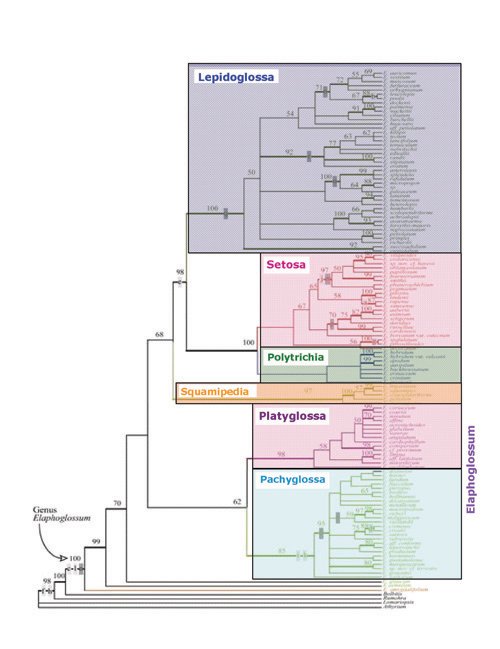Elaphoglossum Phylogeny
by Alejandra Vasco
Intergeneric relations of Elaphoglossum
The relationships of Elaphoglossum to other ferns have been examined by several molecular phylogenetic studies. The monophyly of the genus and its placement within the Dryopteridaceae has received strong support from two molecular phylogenetic studies (Liu & al., 2007; Schuettpelz & Pryer, 2007). These molecular studies suggest thatElaphoglossum is part of a clade that also contains the genera Lomagramma,Teratophyllum, and Bolbitis.
Intrageneric relationships of Elaphoglossum
There have been several attempts to split Elaphoglossum in smaller groups to make it more manageable taxonomically (Fée, 1845; Sodiro, 1893; Christ, 1899; Holttum, 1966; Mickel & Atehortúa, 1980). The most recent and comprehensive of these (Mickel & Atehortúa, 1980) divides Elaphoglossum into nine sections and 21 subsections, and provides keys to distinguish these groups. This study, which is a non-cladistic, morphological one, has served as the main framework for further taxonomic and phylogenetic studies of Elaphoglossum.
Phylogenetic relationships within Elaphoglossum have been examined by two studies using chloroplast DNA (Rouhan & al., 2004; Skog & al., 2004). These studies clearly support five of the nine sections originally proposed by Mickel and Atehortúa. The five clades were: 1) the Amygdalifolia clade, sister to the rest of the genus and consisting of the single species E. amygdalifolium (Mett. ex Kuhn) H. Christ, characterized by long-creeping rhizomes, hydathodes, phyllopodia, and reddish young fronds; 2) the Elaphoglossum clade, consisting of two well supported subclades Platyglossa and Pachyglossa, which are sister and contain species with phyllopodia and inconspicuously scaly or glabrous laminae (no known macromorphological characters separate the two subclades, but their perispores differ; Moran & al., 2007); 3) the Squamipedia clade, characterized by long-creeping rhizomes, distichously arranged leaves, 1-2 mm long peg-like aerophores, leaves less than 15 cm long, and echinulate spores; 4) the Subulata clade, characterized by subulate scales (enrolled at the base); and 5) the Lepidoglossa clade, sister to the subulata clade and characterized by phyllopodia, scaly laminae, and scales with acicular marginal cells.

Our goal is to continue exploring the genus morphologically and molecularly, to include more species to test the monophyly of the major clades, and to find consistent morphological characters to define them. By combining molecular and morphological phylogenetic data, we hope to detect small clades that can be conveniently monographed.